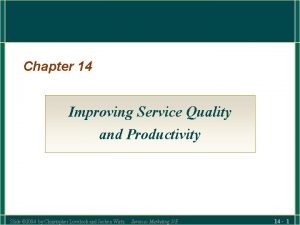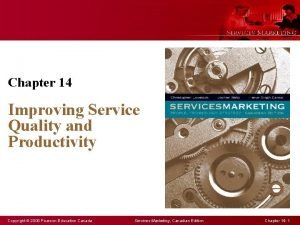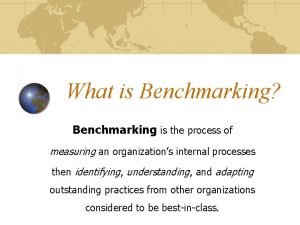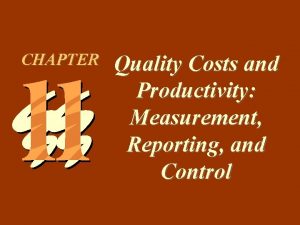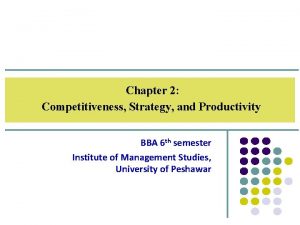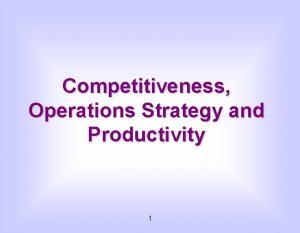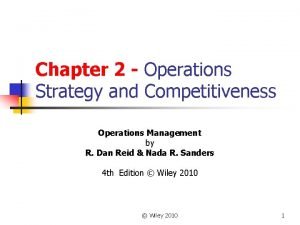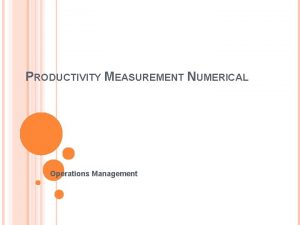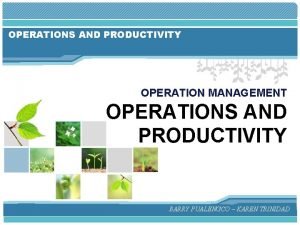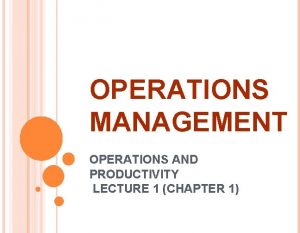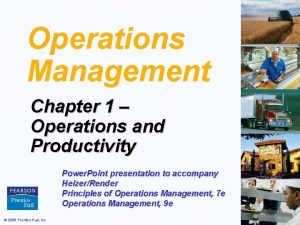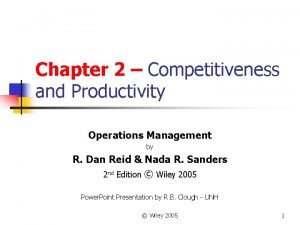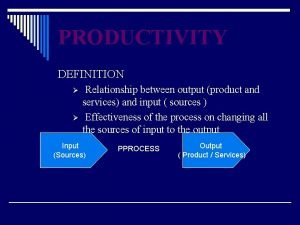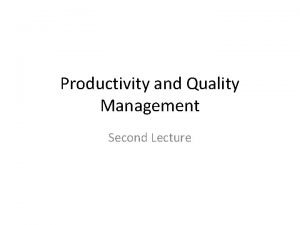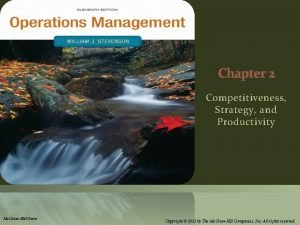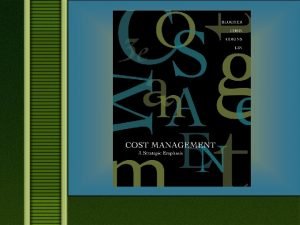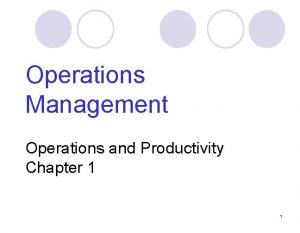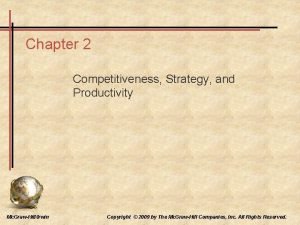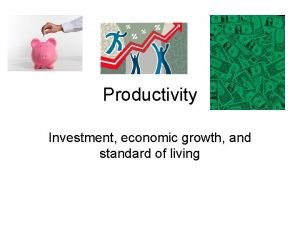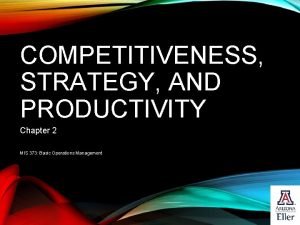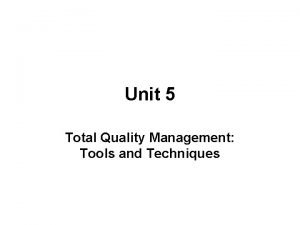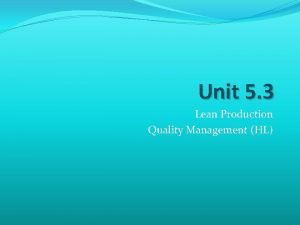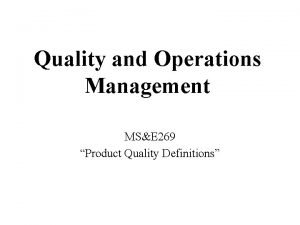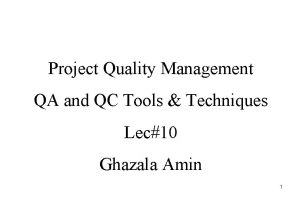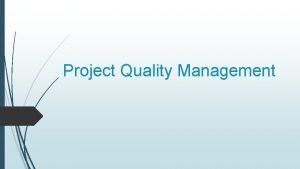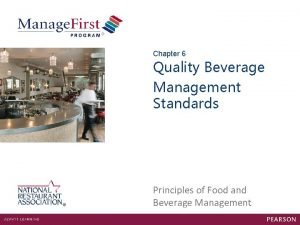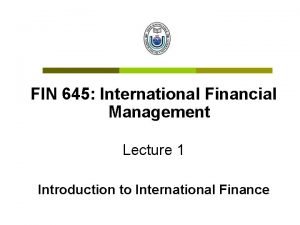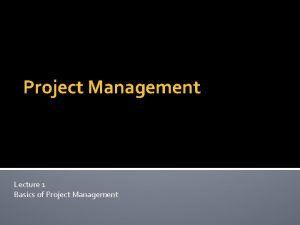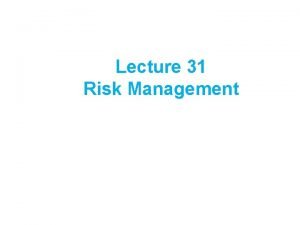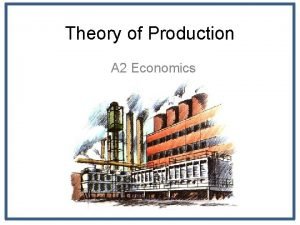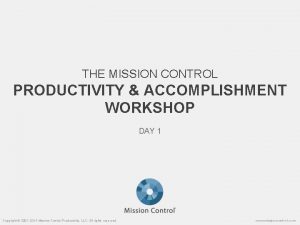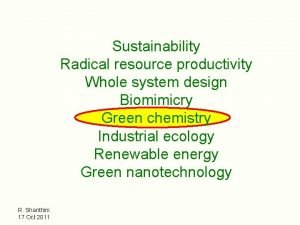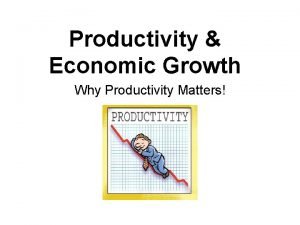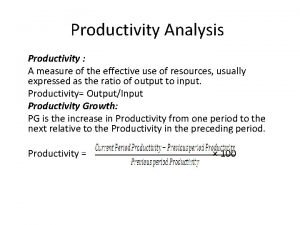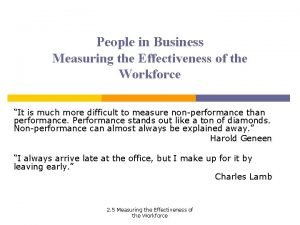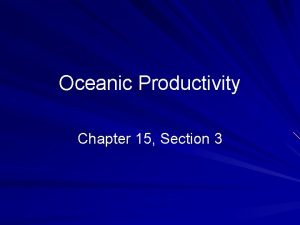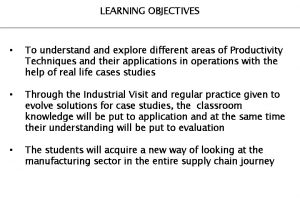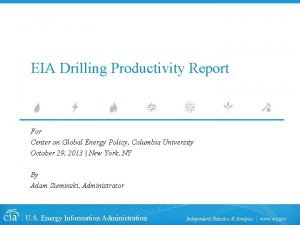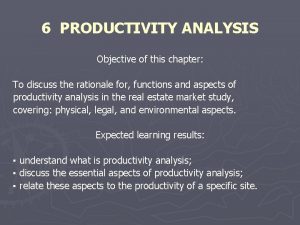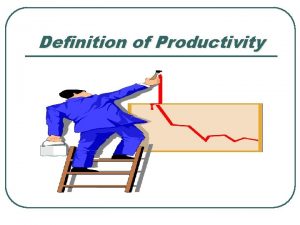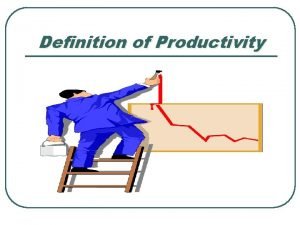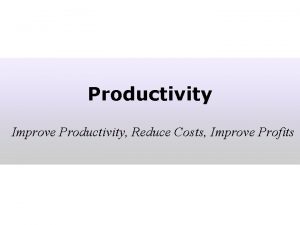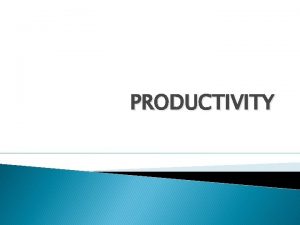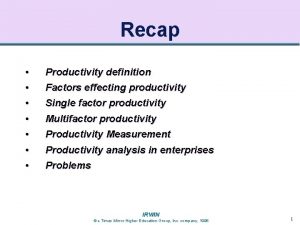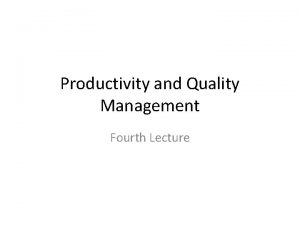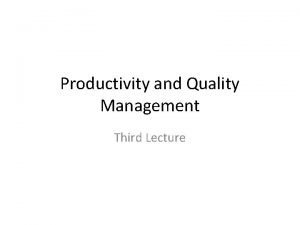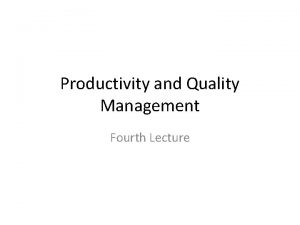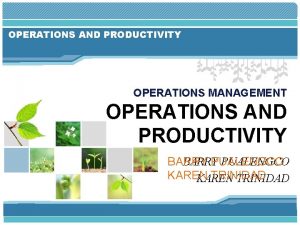Summary Lecture Productivity and Quality Management Lecture No








































![Eight Pillars of TPM Activity • TPM has 8 pillars of activity, [2] each Eight Pillars of TPM Activity • TPM has 8 pillars of activity, [2] each](https://slidetodoc.com/presentation_image_h2/9052c3c9e79d5daf84daa27352d11056/image-41.jpg)










































- Slides: 83


Summary Lecture Productivity and Quality Management

Lecture No. 1 • Productivity and Quality Introductory Lecture • Topics Introduced – Productivity – Factors Affecting Productively – Productivity at National Level – Quality – Total Quality Management (TQM) – Product and Service Quality – Total Productive Maintenance (TPM)

Lecture No. 2 • • The Role of Productivity Misconceptions about Productivity Benefits of Productivity Model of Low Productivity Trap

Productivity • Single-factor measures – Output / (Single Input) • All-factors measure – Output / (Total Inputs) 5

Lecture No. 2 • Misconceptions – First, productivity is not only labour efficiency or ``labour productivity – The second misconception is that it is possible to judge performance simply by output. – The third problem is confusion between productivity and profitability. – Fourth there is one more misunderstanding – confusing productivity with efficiency.

Model of the Low Productivity Trap Low productivity growth (compared with input prices) Lagging capital formation (insufficient capital ratio) Rising Prices (domestic and export goods) Lower utilization of domestic plant capacity Rising unit (labor and energy) cost Sluggish sales (in domestic and foreign markets)

3 rd Lecture • • History of Background of Productivity Models Productivity Measurement Models Productivity Improvement

Ways of Calculating Productivity

Ways to Improve Productivity

Ways to Improve Productivity

Lecture No. 4 • Role of Productivity in Operations Management • Efficiency Versus Effectiveness • Production and Productivity • Productivity Calculations • Example of Productivity

Productivity Calculations Labor Productivity = Units produced Labor-hours used 1, 000 = = 4 units/labor-hour 250 One resource input single-factor productivity © 2011 Pearson Education, Inc. publishing as Prentice Hall

Multi-Factor Productivity = Output Labor + Material + Energy + Capital + Miscellaneous u Also known as total factor productivity u Output and inputs are often expressed in dollars Multiple resource inputs multi-factor productivity © 2011 Pearson Education, Inc. publishing as Prentice Hall

Lecture No. 5 • Improving Productivity – Historical Background – Productivity Growth • Productivity Improvement Factors (1 st Theory) – Internal Factors – External Factors • Productivity Improvement Factors – Technical Factors

Productivity improvement factors External Factors • Factors which are external and not controllable for one institution are often internal to another. • Factors external to an enterprise are of interest to that enterprise because an understanding of them can motivate certain actions which might change an enterprise behavior and its productivity in the long run.

Productivity improvement factors Internal Factors • Since some internal factors are more easily changed than others it is useful to classify them into two groups: – Hard (not easily changed) – Soft (not easily changed)

Lecture No. 6 • Productivity Improvement Factors • • • Organizational Factors Management Factors Production Factors Government Factors Finance Factors Government Factors

Factors that affect Productivity The eight main factors that affect productivity are:

Lecture No. 7 • Productivity and Global Economic Growth and Development – Background – Economic Growth – Causes of Economic Growth – Economic Development – Issues and Applications

How Do We Define Economic Growth (cont’d)? • There are two ways to define economic growth, depending upon the final goal. – An increase in real GDP over time – An increase in real per capita GDP over time • The second definition is superior if the objective of the analysis is a comparison of living standards. 9 -21

Economic Growth • The key determinants of economic growth – Increases in the labor force, the growth of capital, and the growth of productivity • New growth theory – Emphasizes how rewards to innovation contribute to higher growth rates • Fundamental factors that contribute to a nation’s economic development – Nations that encourage education, have a strong system of property rights, allow creative destruction, and avoid protectionism have higher levels of productivity and economic development

Lecture No. 8 • Productivity indices help us to evaluate economic performance and the quality of social and economic policies. • Productivity Analysis helps identify factors affecting income and investment distribution within different economic sectors, and helps to determine priorities in decision making. • In enterprise, productivity is measured to help analyze effectiveness and efficiency. • Its measurement can stimulate operational improvement

Labor Time Method • Total Productivity is the average of labor and capital productivity weighted and adjusted to price fluctuation. • It can be calculated by labor time method. • All materials, depreciation, services and final products can be converted into manpower equivalents by dividing the output by input in financial terms, this being divided again by the national or sectoral average annual income per employee:

Labor Time Method This gives The indices used above are complex and not very precisely defined.

National Labor Productivity • At the national level labor productivity is computed by taking the entire economically active population as the input and the total value of goods and services produced as the output National productivity = A more useful way of measuring national labor productivity is to divide output by “hours potentially workable” in order to take account of labor wasted by unemployment.

Lecture No. 9 • Performance and Productivity in Non-profit organizations – Performance and Productivity – Public and Private Organizations – Some reasons for Performance – Major Performance Challenges • • Stakeholders Organizations Projects People

Performance Problems of Stakeholders • Problem 1: Needs of target groups are not sufficiently met. – Variations: Programs are absent or too small to meet target group needs, programs or policies perform poorly, client groups feel disenfranchised or excluded from decision-making processes, target groups have unrealistic expectations. • Problem 2: Individuals who interact with the agency are dissatisfied. – Variations: Unresponsiveness by agency staff, poor mix of interaction mechanisms, inadequate frontline service. • Problem 3: Citizens, clients, or community leaders are apathetic about the program. – Variations: Inadequate enthusiasm for new programs, inadequate support of agency goals and staff. • Problem 4: Individuals or groups are making politics at the expense of the organization.

Performance Problems of Organizations • Many performance problems are caused by failure to adhere to basic principles of organizational design. • This can produce symptoms such as infighting, lack of direction, micromanagement, spending too much time on coordination, plans that gather dust, and the inefficient use of or acquisition of resources. • Employee de-motivation may occur as a secondary result. • These problems affect programs as well as agencies as a whole.

Performance Problems of Projects • When projects are managed poorly, they fall behind schedule, lack relevance, exceed costs, and fail to meet standards, yielding stakeholder dissatisfaction or apathy. • They fail to contribute to the agency’s mission. • Project management is about avoiding these outcomes. • The hallmark of properly managed programs is that they achieve their objectives – (1) on time, – (2) within budget, and – (3) at or above quality and performance specifications.

Performance Problems of People • People are key to making organizations work. • When they fail, so too do many organizations and their programs. • People are a critical resource. • Typical symptoms of people problems are people shunning their work, their manager or their coworkers, staff de-motivation, formal or informal complaints against a person, projects falling behind, and lack of new programs, successful programs, or program leadership

Lecture No. 10 • Quick Productivity Appraisal approach (QPA) – Integrated audit approach – Includes diagnosis and monitoring of a productivity improvement program covering a whole organization. • Components – Company Performance Appraisal (CPA) – Qualitative assessment – Industry Performance Appraisal


Steps in Company Performance Appraisal (CPA) How to conduct CPA?

Lecture No. 11 • Total Productive Maintenance – Philosophy of Total Productive Maintenance (TPM) – History of TPM – Types of Maintenance – TPM Policies and Objectives – Similarities and Differences between TPM and TQM

The TPM Philosophy

Lecture No. 11 • • • TPM Models and Theories 5 S Theory Pillars of TPM Implementation Benefits of Applying Total Productive Maintenance

Components of TPM

Lecture No. 12 • • • TPM Models and Theories 5 S Theory Pillars of TPM Implementation Benefits of Applying Total Productive Maintenance

5 S Philosophy �Based on five Japanese words that begin with ‘S’, the 5 S Philosophy focuses on effective work place organization and standardized work procedures. 5 S’s 1. Sort : (Seiri) 2. Set In Order: (Seiton) 3. Shine: (Seiso) 4. Standardize: (Seiketsu) 5. Sustain: (Shitsuke)
![Eight Pillars of TPM Activity TPM has 8 pillars of activity 2 each Eight Pillars of TPM Activity • TPM has 8 pillars of activity, [2] each](https://slidetodoc.com/presentation_image_h2/9052c3c9e79d5daf84daa27352d11056/image-41.jpg)
Eight Pillars of TPM Activity • TPM has 8 pillars of activity, [2] each being set to achieve a “zero” target. These 8 pillars are the following: – – – – Focused improvement (Kobetsu Kaizen); Autonomous maintenance (Jishu Hozen); Planned maintenance training and education early-phase management quality maintenance (Hinshitsu Hozen); Office TPM Safety, Health & Environment • Some organizations also additional pillars according to their work place like: – Tools Management – Information Technology

Lecture No. 13 • Factors that improve productivity in Oil and Gas: 1). Integrating Automation 2). Introducing Smart business processes 3). Improving safety 4). Risk Mitigation 5). Innovations 6). The Human element

Key areas to be looked into in Oil and Gas

Lecture No. 14 • • • History of Motion and Time Study Defining Work Systems and Productivity Methods Design Motion Study Work Methods Design

Motion and Time Study • Motion and time study helps management determine how much is produced by workers in a specific period of time, therefore making it easier to predict work schedules and output. • Motion and Time Study is a scientific method designed by two different people for the same purpose, to increase productivity and reduce unit cost. • The two methods evaluate work and try to find ways to improve processes.

HISTORY OF MOTION AND TIME STUDY Frank B. Gilbreth, Lillian M Gilbreth -1885, he begun to develop motion study. Gilbreth invented motion study designed to determine the best way to complete a job Frederick W. Taylor -1881, he started to develop time study Taylor designed Time Study; it measures how long it takes a worker to complete a task.

Methodology Outline of MTS • Develop System – Design work methods (sequence of operations and procedures) that make up the preferred solution – Find better methods for work Methods Design • Standardize – Form written standards for operations • Time Standards – Determine a standard time for each operation Develop System Work Meas. mnt Time Standards • Training – Train the operators Training

Lecture No. 15 • Work measurement – evaluation of a task in terms of the time that should be allowed by an average worker to perform the task • Time study – all the ways in which time is analyzed in work situations • Standard time – amount of time that should be allowed for an average worker to process one work unit using the standard method and working at normal pace

Time Study and Work Measurement Task Hierarchy & Work Measurement

Time Study and Work Measurement Prerequisites for Valid Time Standards: Factors that must be standardized before a time standard can be set

Lecture No. 16 • • • What is Quality? Century of Quality History of Quality Methodology Deming’s Principles Taguchi’s Contributions And Philosophy

What is Quality? • Conformance to specifications (British Defense Industries Quality Assurance Panel) • Conformance to requirements (Philip Crosby) • Fitness for purpose or use (Juran) • A predictable degree of uniformity and dependability, at low cost and suited to the market (Edward Deming) • Synonymous with customer needs and expectations (R J Mortiboys) • Meeting the (stated) requirements of the customer- now and in the future (Mike Robinson) • The total composite product and service characteristics of marketing, engineering, manufacturing and maintenance through which the product and service in use will meet the expectations by the customer (Armand Feigenbaum)

Taguchi Philosophy • 3 stages in a product’s (or process’s) development: 1) System design: uses scientific and engineering principles to determine the basic configuration. 2) Parameter design: specific values for the system parameters are determined. 3) Tolerance design: determine the best tolerances for the parameters.

Lecture No. 17 • • Total Quality Management Quality Improvement Tools Costs related to quality Benefits/Drawbacks

Evolution of Quality Management Quality Assurance Mass Inspection Quality Control (Acceptance Sampling) Quality Management System Tota l Man Qualit agem y ent Company wide Quality Control

The Acceptance Inspection Model Process Inspection Pass the Inspection? NO YES Acceptance Next Process Reject, Scrap, Rework, Repair

Lecture No. 18 • The Quality Management Paradigms – Inspection Era – Statistical Quality Control Era – Quality Assurance Era – Strategic Management Era – Total Quality Management

The Four Major Quality Eras

The Four Major Quality Eras

The Four Major Quality Eras

Lecture No. 19 • The Quality Management Philosophies • Deming’s System of Profound Knowledge • Perspectives on Profound Knowledge

Theory of Profound Knowledge - knowledge for leadership of transformation 1. Appreciation for a system – 2. Knowledge of variation – 3. Understanding where the processes are stable Theory of knowledge – 4. A network of interdependent components that work together to try to accomplish the aim of the system. Without aim there is no system. Predicting and anticipating what will happen if certain actions are taken Psychology of individuals, society and change. – Appreciate people’s natural inclination toward learning and being innovative.

Lectures 20 and 21 • Leaders in the Quality Revolution – W. Edwards Deming – Joseph M. Juran – Philip B. Crosby – Shingo – Ishikawa – Genichi Taguchi – Peter Drucker – Tom Peters Slide 3. 2

Deming’s Philosophy • Quality is about people, not products • Suggested quality concept for designing product • Management need to understand nature of variation and how to interpret statistical data • Promoted importance of leadership • 85% of production faults responsibility of management, not workers • Enumerated a 14 -point management philosophy

Juran’s Quality Trilogy • Quality planning – Preparing to meet quality goals • Quality control – Meeting quality goals during operations Q. P • Quality improvement – Reaching unprecedented levels of performance Q. C. Slide 3. 17 Q. I.

Philip B. Crosby’s Philosophy Absolutes of Quality Management: • quality means conformance to requirements – Requirements must be clearly stated so they can’t be misunderstood • problems are functional in nature – Problems must be identified by those individuals that cause them

Lecture No. 22 1. To emphasize the importance of planning in the quality management system. 2. To compare and contrast formal and informal planning. 3. To provide a systematic approach to planning

PDCA Example

Lecture No. 23 -Project Planning • A project plan is made up of significant events or milestones that must occur in some time sequence in order for a project to be completed. • A project plan is a schedule of tasks over the duration of the project • Project plans are an effective means of depicting a project schedule and reporting progress as it occurs. • The type of plan most often used is a Gantt-type chart • When viewing this plan, you should remember that the responsible manager should have a list of all the projects under his or her control along with their associated status. • In turn, each project on the list is then delegated to a project manager.

Lecture No. 24 and 25 Controlling for Quality 1. Define the control process, and discuss the elements of reporting. 2. Develop an appreciation for business, process, and product performance reporting. 3. Introduce and describe the various reporting structures.


Journalizing Procedure • To illustrate the recording of activities in the activity report or log, assume that on May 1, 20 xx, John Doe of the Red Bead Company Sales Department took 500 orders from customers. • Upon review of these orders, three nonconformities were found. • This activity is recorded on the first page of the activity report or log as follows:

Journalizing Procedure

Posting • The process by which the outputs and nonconformance are summarized and transferred to activities on the performance log is called posting. • It consists of transferring totals for the outputs (total) column and the nonconformance (nc) column on the individual activity reports or logs to the performance log.

Lecture No. 26 Staffing for Quality Define the employee-forecasting process, and discuss the elements of resource planning. 2. Develop a scheme for the development of job descriptions and requirements. 3. Describe the various education and training methodologies.


Lecture No. 27 Leadership • The motivation process begins with proper leadership. • Leadership should lead to an appropriate motivating environment which provides consistency in purpose and sincerity, and where goals are realistic and there are no hidden agendas. • Management needs to be aware that each individual has different needs depending on her stage in life and should be treated accordingly. • Operator dissatisfaction will be reflected in her work when these needs are not recognized.

Lecture No. 27 Motivation • The motivation process begins with proper leadership. • Leadership should lead to an appropriate motivating environment which provides consistency in purpose and sincerity, and where goals are realistic and there are no hidden agendas. • Management needs to be aware that each individual has different needs depending on her stage in life and should be treated accordingly. • Operator dissatisfaction will be reflected in her work when these needs are not recognized. • When management communicates in only one direction to employees, mostly through threats and very few rewards, employees will form informal objectives that are diametrically opposed to those of the organization, resulting in ever-decreasing levels of output value.

Lecture No. 28 - TQM • • Definition and Explanation of TQM History of TQM Five Approaches of Quality Characteristics of TQM – – – – Quality chains Company policy and accountability Control Monitoring the process Teamwork Consumer views Zero defects

Lecture No. 29 Introduction to Six Sigma is methodology used for: • Aligning key business processes to achieve those requirements. • Utilizing rigorous data analysis to minimize data variation in those processes. • Driving rapid and sustainable improvement to business processes. 80

Lecture No. 30 Six Sigma Methodologies • BPMS ØBusiness Process Management System • DMAIC ØSix Sigma Improvement Methodology • DMADV ØCreating new process which will perform at Six Sigma

Lecture No. 31 ISO Quality management system • ISO 9000 establishes the requirements for quality management systems (QMS) that must be employed by all organizations registered to the standard. • The eight quality management principles are defined and detailed in ISO 9004: 2000, Quality management systems Guidelines for performance improvements. • Principle 1 Customer focus • Principle 2 Leadership • Principle 3 Involvement of people • Principle 4 Process approach • Principle 5 System approach to management • Principle 6 Continual improvement • Principle 7 Factual approach to decision making • Principle 8 Mutually beneficial supplier relationships

Improving Productivity
 Improving service quality and productivity
Improving service quality and productivity Service quality and productivity
Service quality and productivity Safety quality productivity
Safety quality productivity Benchmarking example
Benchmarking example Project management lecture notes doc
Project management lecture notes doc Cost of quality examples
Cost of quality examples Why is productivity important
Why is productivity important Operations strategy and competitiveness
Operations strategy and competitiveness Productivity and competitiveness in operations management
Productivity and competitiveness in operations management Mrp system ppt
Mrp system ppt Quality assurance vs quality control
Quality assurance vs quality control Basic concepts of quality assurance
Basic concepts of quality assurance 01:640:244 lecture notes - lecture 15: plat, idah, farad
01:640:244 lecture notes - lecture 15: plat, idah, farad Productivity measurement in operations management
Productivity measurement in operations management Operation and productivity
Operation and productivity Operations and productivity
Operations and productivity Productivity definition in operations management
Productivity definition in operations management Productivity definition in operations management
Productivity definition in operations management Operations and quality management
Operations and quality management Operations management with total quality management book
Operations management with total quality management book Plan quality management pmp
Plan quality management pmp Pmbok quality management
Pmbok quality management Define seminar in nursing management
Define seminar in nursing management Compliance vs quality
Compliance vs quality Quality gurus
Quality gurus Crosby's fourteen steps to quality improvement
Crosby's fourteen steps to quality improvement Old quality vs new quality
Old quality vs new quality Project planning and management lecture notes ppt
Project planning and management lecture notes ppt Production and productivity definition
Production and productivity definition What is productivity
What is productivity Journal on healthy food healthy mind
Journal on healthy food healthy mind Properties of human language duality
Properties of human language duality Competitiveness strategy and productivity
Competitiveness strategy and productivity Strategic profitability analysis
Strategic profitability analysis Operations and productivity chapter 1
Operations and productivity chapter 1 Chapter 2 competitiveness strategy and productivity
Chapter 2 competitiveness strategy and productivity Productivity and standard of living
Productivity and standard of living Lam employment absence and productivity scale
Lam employment absence and productivity scale Competitiveness, strategy and productivity
Competitiveness, strategy and productivity Total quality tools
Total quality tools Lean production and quality management
Lean production and quality management Mse operations management
Mse operations management Qcc tools and techniques
Qcc tools and techniques Project management quality tools
Project management quality tools Quality management principles in food and beverage company
Quality management principles in food and beverage company Quality management systems fundamentals and vocabulary
Quality management systems fundamentals and vocabulary Randy pausch last lecture summary
Randy pausch last lecture summary What does reverend cram want the iroquois to do
What does reverend cram want the iroquois to do Project procurement management lecture notes
Project procurement management lecture notes Strategic management lecture
Strategic management lecture Project management for software development
Project management for software development Financial management lecture
Financial management lecture Public sector accounting lecture notes pdf
Public sector accounting lecture notes pdf Operations management lecture notes doc
Operations management lecture notes doc Performance management lecture
Performance management lecture Human resources department structure
Human resources department structure Human resources management chapter 1
Human resources management chapter 1 Human resource management lecture chapter 1
Human resource management lecture chapter 1 Project cost management lecture notes
Project cost management lecture notes Project management lecture
Project management lecture Uphcp
Uphcp Risk management lecture
Risk management lecture Network management principles and practice
Network management principles and practice Top management and middle management
Top management and middle management Top management middle management first line management
Top management middle management first line management Basic concepts of management
Basic concepts of management Marginal productivity formula
Marginal productivity formula Mission control productivity
Mission control productivity Cradle to cradle design
Cradle to cradle design Steiners model
Steiners model Fundamentals of input and output performance
Fundamentals of input and output performance Why productivity matters
Why productivity matters Partial operational productivity
Partial operational productivity Laptops4u
Laptops4u Collins title productivity
Collins title productivity Microsoft office sdk
Microsoft office sdk 15.3 oceanic productivity
15.3 oceanic productivity Productivity table for construction
Productivity table for construction Theory of income distribution
Theory of income distribution American productivity centre model
American productivity centre model Important of housekeeping department
Important of housekeeping department Eia drilling productivity report
Eia drilling productivity report Objectives of productivity
Objectives of productivity Productivity index
Productivity index
